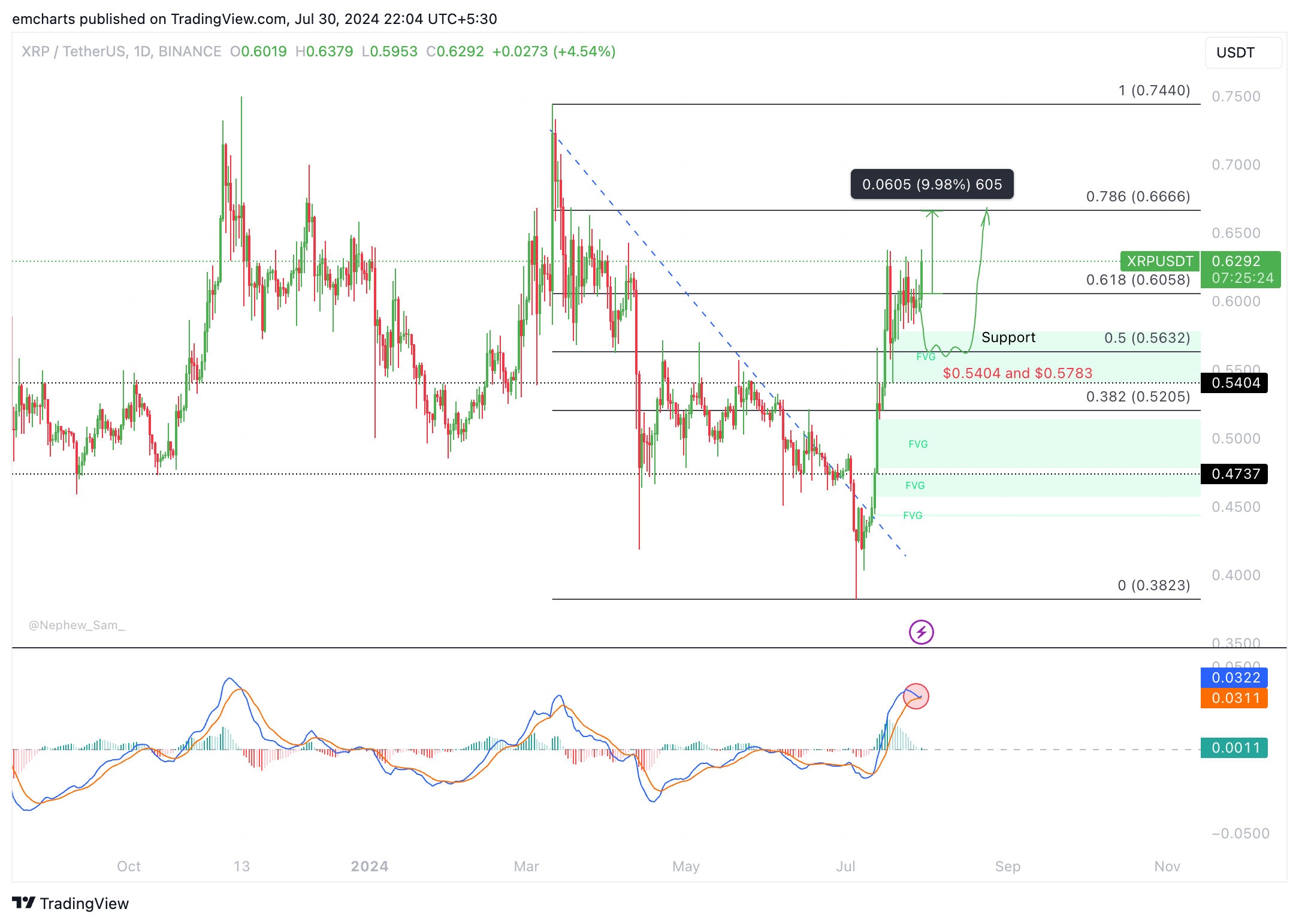Ripple traders hope for court win as SEC backs down on classifying Solana, Cardano and MATIC as securities
- Ripple lawsuit ruling is expected this week as July draws to a close.
- SEC retracted its request for security status of Solana, Cardano and MATIC among other assets.
- XRP extended gains by nearly 3% early on Tuesday, climbing to $0.6183.
Ripple (XRP) traders expect the lawsuit brought by the Securities & Exchange Commission (SEC) to end this week. A pro-crypto attorney, Fred Rispoli, had predicted the end of SEC vs. Ripple lawsuit by July 2024.
The SEC’s move to retract the request for “security status” of Solana, Cardano and MATIC has filled XRP traders with hope for a positive development in the lawsuit.
XRP trades above the key psychological level of $0.60.
Daily digest market movers: Ripple ruling could see positive turn as SEC backs down on security status for these cryptos
- The SEC has retracted its request for “security status” of Solana (SOL), Cardano (ADA) and Polygon (MATIC).
- XRP has legal clarity on its status as a non-security in secondary market transactions, meaning that when traded on exchanges the altcoin is not a security.
- The gray area is the institutional sales of the asset, and this is likely to be addressed in the final ruling in the SEC vs. Ripple lawsuit.
- Judge Analisa Torres had granted a partial victory to Ripple when XRP was declared a non-security in July 2023.
- XRP traders are closely watching the lawsuit for key developments and an end or outcome this week.
- Ripple update: What to expect from XRP and Ripple lawsuit this week.
- Attorney Fred Rispoli, a pro-crypto lawyer, set a deadline of July 31 in his prediction for the lawsuit ruling.
- The Judge is expected to rule on the issue of “fines” or “settlement” to be imposed on the payment remittance firm for the alleged violation of securities laws.
- It also remains to be seen whether the SEC accepts XRP as a non-security or appeals Judge Torres ruling at a later time.
- Rumors of a settlement between the two parties were doing the rounds prior to the closed door meeting on July 25.
- There is no further update in the lawsuit since the two parties filed their letters and responses on the matter of “supplemental authority” or Judge Amy Berman Jackson accepting the XRP ruling as precedent in the SEC vs. Binance lawsuit.
Technical analysis: Ripple could extend gains by 10%
Ripple is trending higher, forming higher highs and higher lows since July 12, as seen in the XRP/USDT daily chart. XRP is likely to sweep support at $0.5632, collect liquidity and extend gains by nearly 10% after. The target is $0.6666, the 78.6% Fibonacci retracement level of the decline from the March 11 peak of $0.7440 to the July 5 low of $0.3823.
Ripple faces resistance at $0.6058, the 61.8% Fibonacci retracement level and the March 25 high of $0.6629.
The Moving Average Convergence Divergence (MACD) indicator supports the thesis of a decline in XRP price since the MACD line crossed under the signal line, marked by a circle in the chart below. This signals underline negative momentum in Ripple’s price trend.

XRP/USDT daily chart
Ripple could sweep lows of $0.5205, the 38.2% Fibonacci retracement on the daily time frame.
Bitcoin, altcoins, stablecoins FAQs
Bitcoin is the largest cryptocurrency by market capitalization, a virtual currency designed to serve as money. This form of payment cannot be controlled by any one person, group, or entity, which eliminates the need for third-party participation during financial transactions.
Altcoins are any cryptocurrency apart from Bitcoin, but some also regard Ethereum as a non-altcoin because it is from these two cryptocurrencies that forking happens. If this is true, then Litecoin is the first altcoin, forked from the Bitcoin protocol and, therefore, an “improved” version of it.
Stablecoins are cryptocurrencies designed to have a stable price, with their value backed by a reserve of the asset it represents. To achieve this, the value of any one stablecoin is pegged to a commodity or financial instrument, such as the US Dollar (USD), with its supply regulated by an algorithm or demand. The main goal of stablecoins is to provide an on/off-ramp for investors willing to trade and invest in cryptocurrencies. Stablecoins also allow investors to store value since cryptocurrencies, in general, are subject to volatility.
Bitcoin dominance is the ratio of Bitcoin's market capitalization to the total market capitalization of all cryptocurrencies combined. It provides a clear picture of Bitcoin’s interest among investors. A high BTC dominance typically happens before and during a bull run, in which investors resort to investing in relatively stable and high market capitalization cryptocurrency like Bitcoin. A drop in BTC dominance usually means that investors are moving their capital and/or profits to altcoins in a quest for higher returns, which usually triggers an explosion of altcoin rallies.

